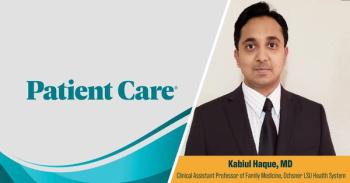
Time to Implement Lung Cancer Screening?
Approximately 90% of cases of lung cancer are attributable to smoking-either directly or as a result of passive exposure. Fifty percent of smokersdie of a smoking-related disease. The 4 most common causes of death-heartattack, lung cancer, chronic obstructive pulmonary disease, and stroke-areall associated with smoking. More lung cancer is diagnosed in former than incurrent smokers.1 The risk of lung cancer decreases each year following smokingcessation, but former heavy smokers will always have a higher risk thannonsmokers.
Q: Screening for early-stage lung cancer is not recommended by theNational Cancer Institute (NCI) or the American Cancer Society (ACS).Why, then, should I consider it for my patients who are current or formersmokers?
A: Approximately 90% of cases of lung cancer are attributable to smoking-either directly or as a result of passive exposure. Fifty percent of smokersdie of a smoking-related disease. The 4 most common causes of death-heartattack, lung cancer, chronic obstructive pulmonary disease, and stroke-areall associated with smoking. More lung cancer is diagnosed in former than incurrent smokers.1 The risk of lung cancer decreases each year following smokingcessation, but former heavy smokers will always have a higher risk thannonsmokers.
Other lung cancer risks include exposure to industrial chemicals (particularlyasbestos), solvents, certain heavy metals and, possibly, radon. But if itwere not for tobacco use, lung cancer would be a rare disease instead of whatit is today-the most common fatal malignancy in both men and women.
This year, approximately 175,000 new lung cancers will be diagnosed, mostlyin advanced and symptomatic stages. Only about 13% of patients will be alive5 years after diagnosis.2 The reason for this dismal statistic is the lack of anysystematic early detection program, even for persons known to be at high risk.Deaths from lung cancer among men are now falling slightly, but the numbersare increasing rapidly in women. The net result is a continuing rise in lung cancerincidence.
The case for screening. Neither the NCI nor the ACS recommends screeningfor early-stage lung cancer3-a position that I oppose. I have made a strongcase for lung cancer screening in high-risk groups.4 Solid evidence exists that inthe population of persons with a history of heavy smoking and airflow obstructionas determined by simple spirometry, the prevalence of lung cancer is 3%to 5% during the 5 years after initial screening. This is a very large number comparedwith the much lower yield of screening programs for breast, prostate,and colon cancers. Early-stage lung cancer has a prognosis comparable to that ofother early-stage cancers.5 Thus, early detection is the only way to improvesurvival.
Today we have the knowledge and technology to detect lung cancer in theearly, asymptomatic stages when improved survival and the likelihood of cureare high. Low-dose CT scanning for peripheral lesions and sputum cytology forcentral lesions can identify most of these cancers. It is time to implement screeningprograms for high-risk patients. We do not need controlled clinical trials toverify that we can find, treat, and cure lung cancer right now.
References:
REFERENCES:1. Burns DM. Primary prevention, smoking, and smoking cessation: implications for future trends in lungcancer prevention. Cancer. 2000;89(suppl 11):2506-2509.
2. Swensen SJ, Jett JR, Sloan JA, et al. Screening for lung cancer with low-dose spiral computed tomography.Am J Respir Crit Care Med. 2002;165:508-513.
3. Smith RA, Cokkinides V, von Eschenbach AC, et al. American Cancer Society guidelines for the earlydetection of cancer. CA Cancer J Clin. 2002;52:8-22.
4. Petty TL. The early diagnosis of lung cancer. Dis Mon. 2001;47:204-264.
5. Mountain CF. Lung Cancer: A Handbook for Staging, Imaging, and Lymph Node Classification. Austin:University of Texas Press; 1999.
Newsletter
Enhance your clinical practice with the Patient Care newsletter, offering the latest evidence-based guidelines, diagnostic insights, and treatment strategies for primary care physicians.














































































































































































































































































































